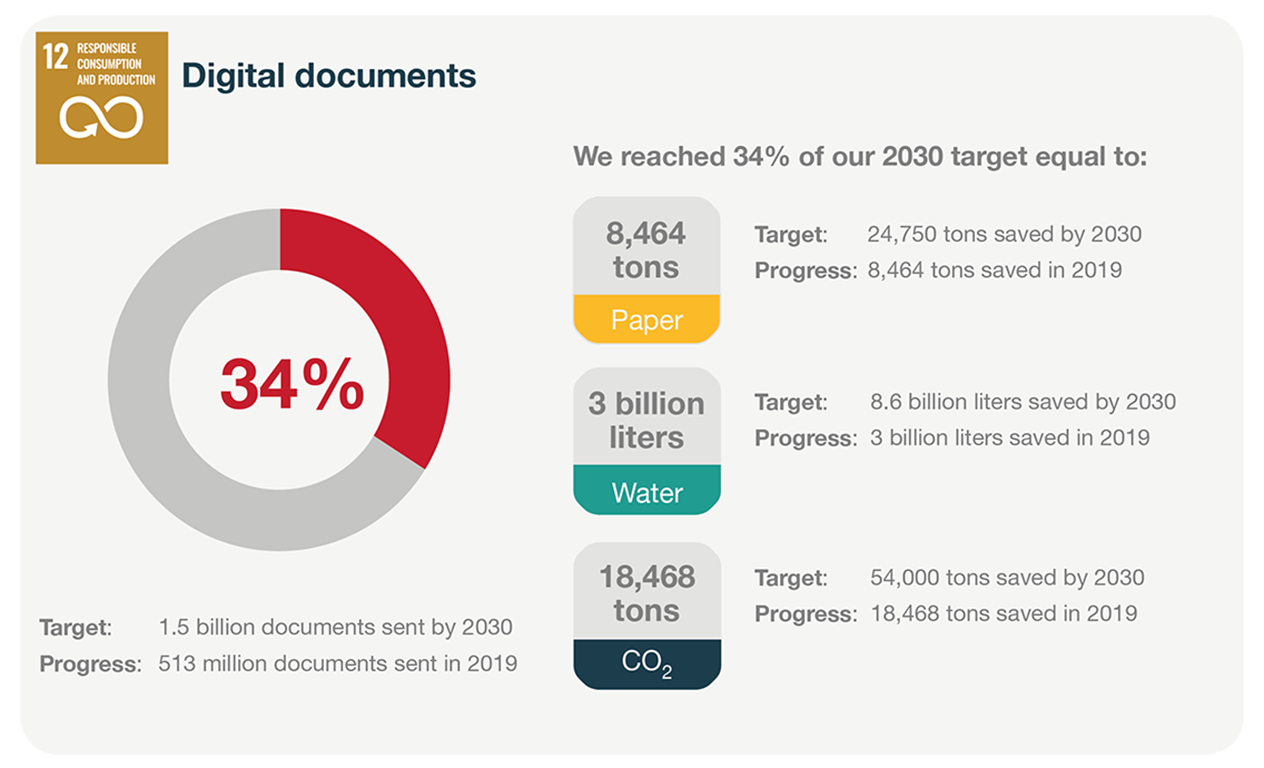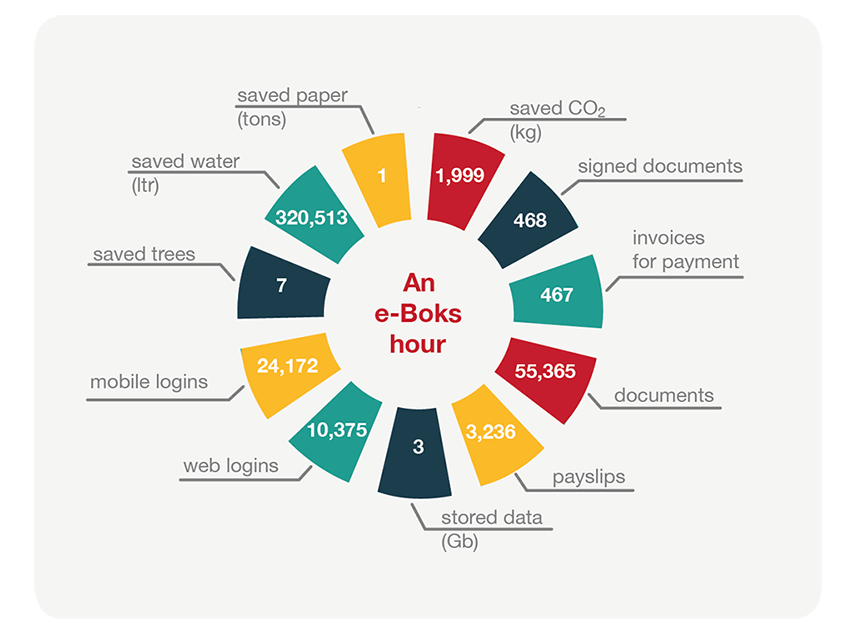A sustainable, paperless future for telecom

It’s the eleventh hour. Man’s actions are contributing to the fast deterioration of Earth. We constantly hear the words global warming and climate change being tossed around as the world experiences worsening natural catastrophes, floods, and disturbed ecosystems.
In 2020, the World Economic Forum listed their top five issues likely to pose a major impact over the next decade and all of them were environmental, with the climate crisis landing the top spot.
If you want to continue living on this planet, then it’s time to decrease your carbon footprint. If you want to make a bigger impact, consider reducing your business’ overall carbon footprint as well.


77%
Of consumers believe that sustainability in businesses is important for them.
One’s carbon footprint is the total amount of greenhouse gas emissions caused by pretty much one’s entire lifestyle. To put it more specifically, the New York Times describes it as resulting “from the production, use, and end-of-life of a product or service.”
Greenhouse gases, on the other hand, are gases that trap heat in the atmosphere, the most common being carbon dioxide (which was at an all-time high in 2019), methane, nitrous oxide, and fluorinated gases.
Greenhouse gas emissions have been on the rise since industrialisation. Around 75% of which can be attributed to humans burning fossil fuels; and in 2019, only 20 firms are responsible for one-third of all carbon emissions.
It is difficult to measure one’s carbon footprint. Standard computations usually apply average values that are not always accurate. For example, eating meat normally ranks high on the scale, but the scale doesn’t usually account for the cow’s diet or the size of the farm, either of which factor in carbon footprint.
Most carbon footprint calculators consider three factors when computing: energy, transportation, and waste. For a company, other things to account for would be the number of employees, the size of the office, corporate logistics, and, of course, its value chain.
Following is some key elements to consider to help understand your company’s carbon footprint and what you can do to make your company more sustainable.
Why do you want to know your company’s carbon footprint? Do you want to reduce it? Do you want to become more sustainable? How will cutbacks affect your office’s system or your overall value chain? Knowing the answers to these questions will help you know where to begin and how to strategise the inevitable diminution.
Bear in mind that, on a company level, the carbon footprint can be computed in a variety of ways depending on your business goals. However, any company who wants to be aware of its carbon footprint and its corresponding impact is already on some ecological path. Come up with environment-friendly policies that will put one’s entire company on board. Then, develop practical solutions towards these goals.
For example, we at e-Boks developed a 2030 SDG 12 ambition, complete with environmental objectives, including water, carbon dioxide, and paper saved, that will be tracked annually.

Reducing a company’s carbon footprint is not as simple as deciding to require reusable coffee cups or switching to an electric car. Do an assessment of your company’s value chain. Which emit the most greenhouse gases? Which do not? Which are dispensable? Which are aligned with your company philosophies?
One will find that many of the biggest contributors to greenhouse gas emissions are directly or indirectly linked to company routines.
Transportation
Electricity production
Industry
Commercial and residential
Agriculture
Land use and forestry
Established in the ’90s after realising the need for an international method for measuring GHG emissions, the Greenhouse Gas Protocol provides regulations as well as tools for businesses and government to measure and manage climate-warming emissions.
The protocol classifies emissions into three groups:
Scope 1: Direct emissions from owned or controlled sources (air-conditioning, cars, company cars)
Scope 2: Indirect emissions in the company’s value chain (purchased electricity)
Scope 3: Activities of the company from sources that they do not own or control (travel, waste, water, products)
The third scope is usually the biggest contributor as well as the most far-reaching.
By identifying the scopes, one also learns the critical areas which need to be prioritised. To calculate the tonnes of carbon dioxide released, an emission factor—as well as a specific time frame—has to be selected for each emission source.
A smaller company might be able to get an informative enough computation using a calculator, but bigger organisations may benefit more from following the GHG Protocol. Many consultancy firms also offer this service, complete with a methodology on how to decrease the carbon footprint based on the company’s requirements.
Without a doubt, companies are quickly moving to improve their carbon footprint. Many corporations, especially the big ones, aren’t privy to the fact that the planet is in danger. More and more of these corporations are taking measures to future-proof their investments by investing in environmental sustainability. Here are some famous brands that are taking the lead towards conservatism.
The German automobile brand has been named world’s most sustainable car manufacturer several times due to its clean production processes and push for fuel-efficient and alternative vehicles.
The food giant made the commitment to recycle 100% packaging, reduce use of water at farms, and use green energy at its 800 plants and warehouses by 2025.
We at e-Boks have established our business by delivering sustainable digital solutions on a platform that enables digital distribution, interaction, and storage of digital information.
Together with customers and users, we contribute to huge environmental savings, compared to traditional paper mail. By turning companies into fully digital organisations, we cut back on infrastructure and inevitably, carbon footprint. By 2030, we plan to reach 1.5 billion digital document transactions annually.
This plant-based meat company cuts the need for agricultural farms which are some of the biggest causes of carbon dioxide emissions.
With travel being a huge culprit in emissions, this airline company invested more than $16 billion to replace its entire fleet with fuel-efficient models.
All Disney theme parks use zero net direct greenhouse gas emissions. Disney also has a zero-waste policy.
In 2017, Google purchased a kilowatt-hour of renewable energy from a wind or solar farm that was built for Google for every kilowatt-hour of electricity it has consumed. It has also partnered with the Renewable Energy Buyers Alliance and Resource Platform to have even greater access to renewably sourced energy.
Are there any specific yet operational processes in your company that can cause a larger carbon footprint? For example, does sending emails to leave a carbon footprint? Does using paper leaves a bigger carbon footprint?
What we know is that many companies are also shifting to the digital landscape. While electric consumption undoubtedly releases GHGs, more analog processes like printing paper, commuting and staying in an office, and traveling have a wider negative impact on the environment. In fact, carbon dioxide emissions were reduced when people were locked down and forced to shift online due to the COVID-19 pandemic.
Take for example our initiatives at e-Boks. We manage to not only eliminate these extra efforts but also reduce our carbon footprint by providing location-independent access to secure digital posts—no paper, no commute, happier planet.
Moreover, we are also self-conscious about energy consumption, as we plan to diminish our own environmental footprint by aiming to source 100% carbon-neutral data by 2030. In 2019, we began our goal of planting 10,000 trees annually, reaching 120,000 trees also by 2030.

It’s not too late to decrease the carbon footprint of one’s company. Whether the organization is big or small, there are many ways to go about being more environmentally conscientious.
The beauty of even smaller environmental actions is that it has a multiplier effect. One person who starts walking to work may seem trivial, but imagine if nearly all the people in a company do.
Here are some ways a business can reduce its carbon footprint:
We hate to say it, but rules will be the first reason everyone will want to toe the line. Set up segregated bins. Require everyone to bring reusable eating wares. Encourage carpooling. Establish rules for efficient consumption. Invest in energy- and water-saving technologies. Enforce zero-waste policies. One can even encourage tree-planting activities.
Being green and reducing one’s carbon footprint is also good for business. A Forbes article mentioned that over 80% of consumers respect businesses with green practices. This is echoed by a 2020 IBM study which states that 77% of consumers believe that sustainability in businesses is important for them. Then there are known tax credits and incentives, improved efficiency, healthier workplaces, and cost savings when it comes to shifting to more environmentally sound policies.
Make sure everyone is on board with the company’s environmental goals. Make them understand the reasons behind the company’s new decisions and why they suddenly need to bring metal straws. Comprehension is key to motivation.
You need to have a goal to create a habit. Having a little prize for employees who follow ecological policies might serve as an impetus to adopt a new lifestyle.
Think long-term and invest in technology that can help decrease your carbon footprint in the long run. From toasters to refrigerators, there’s pretty much a green counterpart for every device.
Heating and cooling are probably some of the biggest contributors to a company’s carbon footprint. Check SEER scores—for central air-conditioners, a higher seasonal energy-efficiency ratio means it’s better. For heating, the most efficient boilers have an AFUE (annual fuel utilization efficiency) rating of 85% or greater.
Food waste is a major problem across the world. Reduce food waste in your corporate cafeteria with quick fixes such as serving appropriate proportions of food and decluttering the refrigerators. Also, try to encourage plant-based food products as much as possible to stretch the effects of your environmental efforts beyond the company.
Reduce, reuse, recycle: this waste hierarchy was all the vogue in the ’70s and it remains to be a guiding mantra today. Many people tend to wax poetic on recycling, but it pays to remember that it’s the last step in the cycle as recycling tends to consume earnest amounts of energy. Try downsizing one’s lifestyle first. It’s also the most cost-efficient.
This is an incredibly simple yet shrewd way to cut down on one’s carbon footprint. With documents and mail, companies can take down whole forests with its paper usage. Not only will trees be saved and water consumption be reduced, but going digital can also conserve storage space, save on resources, and even prevent disputes thanks to its proverbial paper trail.
Learn more about how your company can become paperless
It’s just environmentally ethical. Here is a vital statistic to remember: paper accounts for around 26% of total waste at landfills. According to The World Counts, a total of 386 million hectares of forest were lost from 2001 to 2019—and the global consumption of paper and pulp is expected to increase until 2060, putting an even heavier strain on the already critical state of the world’s forests.
Paper is wasteful. Apart from the pressure on the forests, other resources are consumed just to create paper, including water and oil. Producing paper actually uses twice as much energy as it takes to produce plastic.
Paper is just excessive. Just imagine the physical space that paper takes up. By going digital, one can easily store an entire mailroom in the cloud.
There’s hardly a need for infrastructure. It bears to emphasize that with fewer physical materials, one would require smaller physical space—if at all. With the smaller infrastructure, there’s less energy consumption.
Digital communication is faster and cheaper. Paper was originally invented as a tool for communication, but nowadays it’s more for packaging. Do people even remember how long it took for snail mail to arrive? Then there’s the matter of going to the post office, keeping letters in boxes, and postage costs. Messages or documents in a digital postbox can be stored for future reference. There are timestamps, notifications, and faster exchange.
Going paperless doesn’t just save you the cost of buying reams of paper. Less paper means less printing which means less ink and less maintenance for printers.
Forget filing. Saving and organising and retrieving information is so much easier. The cloud or other digital storage spaces can easily be shared among colleagues. Paperless documentation also makes data transportation much more convenient.
Backups and security. The digital space makes it easier to create backups for documents, as well as backups for backups. Many cloud-based companies have also installed high-level security to protect data privacy.
A fully digitised office would make the company’s processes more transparent and accessible. And, as the world moves towards remote working, it eliminates the need for brick-and-mortar premises.
Take the initiative. Just like going green, management needs to take charge and establish the groundwork for going paperless. Make the transition easier on the employees by accepting the transfer of digital documents, allowing e-signatures, installing a cloud, cutting the red tape on the approvals. Conversion isn’t always an instant process, so alleviate the confusion by discussing very clearly and early on how the company’s outmoded paper processes would shift to digital.
Address compliance concerns. The idea of going paperless is always a concern for legal and finance departments due to the lack of security of actual paperwork. In truth, becoming digital helps keep track of documents better. Invest in a security feature to ensure that sensitive content is protected.
Eliminate paper sources. Necessity is the mother of all inventions. Sometimes, just having all that paper around will keep people set in their old ways. Slowly wean them off. When employees realize that all the paper is gone in the stockroom, they’re forced to choose digital.
Organize your old papers. Go through the filing cabinet and sort through all the dusty antique one has hidden there. Check which documents can be digitised and which need actual hard copies. Only when one has moved on from these can he fully embrace a digitized system.
Install appropriate software and a digital solutions provider to really take you to the digital age. Once one has fully embraced a paperless journey, it would be easier to hire someone to come up with tailor-fit digital solutions for the company. At e-Boks, we provide secure platforms and digital postboxes that can help employers and employees shift to the digital sphere We offer a digital solution to increase effectiveness and reduce costs:
Secure distribution
We have a platform for communication and distribution of messages and documents, setting up companies with a system to handle dispatch processes. Companies are assured of cost-effectiveness (against manual distribution), guaranteed delivery, lower manual workload, and security.
A sustainable platform
As a bonus, digitizing your workspace also helps the environment. When your company uses the e-Boks platform to transfer data, then you become committed to moving towards climate-neutral data. We at e-Boks have also partnered with KMD, which provides our data center, to reduce energy consumption and switch to renewable energy. Our cloud is also powered by windmills. Not only are we planting trees, but this activity has also served as a sustainable livelihood for smallholder farmers.

Ready to quit paper? Say good-bye to papercuts, because folding, printing, and shredding will be a thing of the past after you partner with us.